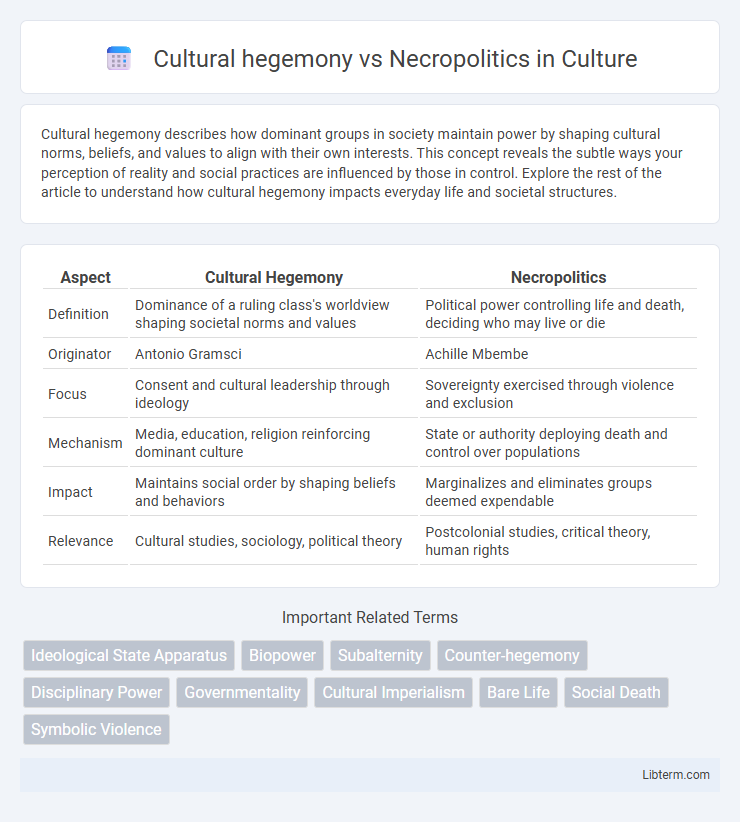Cultural hegemony describes how dominant groups in society maintain power by shaping cultural norms, beliefs, and values to align with their own interests. This concept reveals the subtle ways your perception of reality and social practices are influenced by those in control. Explore the rest of the article to understand how cultural hegemony impacts everyday life and societal structures.
Table of Comparison
| Aspect | Cultural Hegemony | Necropolitics |
|---|---|---|
| Definition | Dominance of a ruling class's worldview shaping societal norms and values | Political power controlling life and death, deciding who may live or die |
| Originator | Antonio Gramsci | Achille Mbembe |
| Focus | Consent and cultural leadership through ideology | Sovereignty exercised through violence and exclusion |
| Mechanism | Media, education, religion reinforcing dominant culture | State or authority deploying death and control over populations |
| Impact | Maintains social order by shaping beliefs and behaviors | Marginalizes and eliminates groups deemed expendable |
| Relevance | Cultural studies, sociology, political theory | Postcolonial studies, critical theory, human rights |
Understanding Cultural Hegemony: Foundations and Influence
Cultural hegemony, a concept developed by Antonio Gramsci, refers to the dominant socio-cultural norms and values that shape societal structures and maintain the power of ruling classes through ideological means. It operates by embedding hegemonic beliefs into everyday institutions and media, influencing public perception and consent without direct coercion. Understanding cultural hegemony reveals how power is maintained through cultural dominance, contrasting with necropolitics, which exerts control through life and death decisions in political sovereignty.
Defining Necropolitics: Power Over Life and Death
Necropolitics, a concept developed by Achille Mbembe, explores the exercise of power through the capacity to dictate who may live and who must die, shaping sovereign control beyond traditional political mechanisms. Unlike cultural hegemony, which emphasizes domination through ideological and cultural consensus as theorized by Antonio Gramsci, necropolitics centers on the sovereign's authority to manage life, death, and social death in contexts such as war, colonization, and systemic violence. This framework critically examines how marginalized populations are subjected to conditions that enforce death or reduce life to a state of bare survival, thereby redefining power relations in biopolitical terms.
Historical Roots: Emergence of Hegemony and Necropolitics
Cultural hegemony, rooted in Antonio Gramsci's early 20th-century theories, emerges from the dominant class's control over cultural institutions to maintain social power and ideology. Necropolitics, a concept developed by Achille Mbembe in the early 21st century, traces its origins to colonial and postcolonial contexts where sovereign power dictates who may live and who must die, exposing the violent enforcement of control. Both frameworks historically reveal how power structures manipulate life, death, and consent to sustain dominance in different socio-political eras.
Cultural Hegemony in Modern Societies
Cultural hegemony in modern societies operates through dominant ideologies embedded in media, education, and political institutions that shape public consciousness and maintain social control. This form of power shapes norms and values, reinforcing existing class structures and legitimizing the status quo without overt coercion. Unlike necropolitics, which exerts control through the power to dictate life and death, cultural hegemony subtly governs by influencing collective beliefs and practices.
Necropolitics in Contemporary Governance
Necropolitics in contemporary governance refers to the state's power to dictate who may live and who must die through the control of life and death, often exercised via policies of war, confinement, and systemic violence. This concept, distinct from cultural hegemony which revolves around ideological dominance and consent, exposes the stark mechanisms of sovereignty where marginal populations are subjected to conditions of social and physical death. Understanding necropolitics reveals the ways governments institutionalize exclusion and death as tools of political control in modern societies.
Hegemonic Narratives vs. Politics of Death
Cultural hegemony shapes societal norms by promoting dominant narratives that legitimize power structures and marginalize alternative voices. Necropolitics enacts control through the regulation of life and death, determining which populations are exposed to violence or neglect. The tension between hegemonic narratives and politics of death reveals how dominant ideologies sustain systemic oppression by selectively valuing certain lives over others.
Intersectionality: Where Hegemony Meets Necropolitics
Cultural hegemony orchestrates dominant social norms and power structures that marginalize specific groups, while necropolitics governs the control over life and death, often through systemic violence and exclusion. Intersectionality reveals how overlapping identities, such as race, gender, and class, experience compounded oppression where hegemonic domination enforces necropolitical outcomes. This intersection underscores the critical analysis of power mechanisms that perpetuate social death and annihilation within marginalized communities.
Resistance and Agency against Dominant Powers
Resistance against cultural hegemony manifests through reclaiming marginalized narratives and fostering counter-hegemonic practices that challenge dominant ideologies embedded in societal institutions. In necropolitics, agency emerges by contesting state-sanctioned violence and asserting the right to life within zones of exclusion where sovereign powers dictate death and survival. Both frameworks highlight subaltern struggles to disrupt oppressive power structures by mobilizing alternative forms of identity and collective action.
Global Implications: Cultural Hegemony and Necropolitics Today
Global cultural hegemony shapes international norms through dominant ideological frameworks imposed by powerful states, influencing political and economic systems worldwide. Necropolitics, the power to dictate who may live and who must die, reveals stark inequalities in global health, security, and migration policies, disproportionately affecting marginalized populations. Together, these concepts expose how authority and violence intersect on a global scale, perpetuating systemic oppression and exclusion.
Rethinking Power: Toward Emancipatory Futures
Cultural hegemony, as conceptualized by Antonio Gramsci, reveals how dominant groups maintain power through ideological control, shaping social norms and consent. Necropolitics, introduced by Achille Mbembe, exposes the sovereign power to dictate life and death, highlighting how states exert control through violence and exclusion. Rethinking power involves integrating these frameworks to envision emancipatory futures where domination is dismantled and life-affirming social orders are cultivated.
Cultural hegemony Infographic

 libterm.com
libterm.com